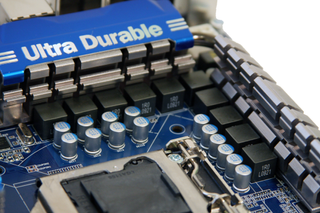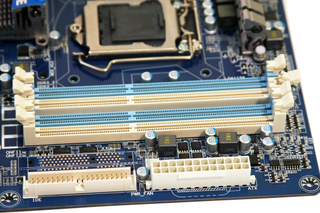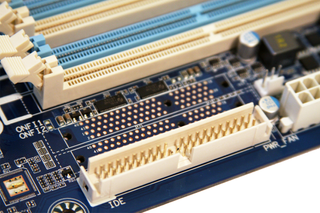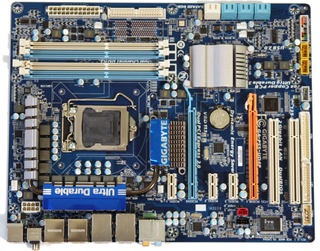Gigabyte's Core i5 Contenders: P55-UD4P And P55-UD6
8-Phase Power

On the other side of those 10 chokes (and under the heatsinks) are the low RDS(on) MOSFET transistors. Gigabyte is calling this a true eight-phase design able to switch down to as few as two phases during light loads.
Now This Is What We're Used To

Dual-channel architecture, four memory slots--yeah, that's a little more like what we'd expect to see (not that the six-slot -UD6 isn't an interesting idea). Despite its two-slot disadvantage, the EP55-UD4P still supports up to 16 GB of DDR3 memory.
Now What Could Go There?

Some of the boards we saw at Computex had ONFi slots soldered onto them. Clearly, this sample doesn't, but it's interesting PCBs are now being defined with the NAND flash interface in mind, even if the P55 chipset won't employ it.
The latest spec revision of the Open NAND Flash interface facilitates performance as high as 200 MB/s, so it could prove to be a significant performance-enhancing feature once it's implemented (unlike Intel's Turbo Memory technology, which did little for notebook performance).
Coming Soon To A Mid-Range System Near You

No word on anticipated pricing for either of these two Gigabyte P55-based motherboards, but we're naturally expecting them to pop up as Core i5 launches, so we'll know soon enough.
Stay on the Cutting Edge
Join the experts who read Tom's Hardware for the inside track on enthusiast PC tech news — and have for over 25 years. We'll send breaking news and in-depth reviews of CPUs, GPUs, AI, maker hardware and more straight to your inbox.
-
mlcloud Pity that it's gonna be hard to get anything stronger than 2x 4870s on these machines.Reply -
cangelini I was running them with a pair of 4870 X2s without a problem. Though I can't publish numbers yet, you'd be surprised how close comparably-clocked i7 and i5-based machines will come.Reply -
paohyean I think the eSATA ports at the back panel are the eSATA/USB combo ports as there are only 2 more headers for 4 front USB ports...Reply
=) -
JeanLuc cangeliniI was running them with a pair of 4870 X2s without a problem. Though I can't publish numbers yet, you'd be surprised how close comparably-clocked i7 and i5-based machines will come.Reply
Have you had a go at overclocking the new Lynnfields yet? It was reported in Custom PC magazine (a publication we get in the UK) that MSI engineers didn't find it hard to push the new Lynnfields to 5Ghz on air. -
cangelini Haven't yet JeanLuc. I'm waiting on two new coolers from a couple of different vendors that should allow a bit more overclocking flexibility. As of now, I'm currently limited to a fairly makeshift cooling setup that isn't really any good for overclocking.Reply -
h83 Is there any chance that the new directx 11 cards will be so powerfull, that only one high end card will be sufficent to max out all the bandwith available, disabling the chance to run a crossfire/sli setup on this boards???Reply
I could be saying something really stupid, but that max 16x bandwith available seems fishy to mee... -
JeanLuc h83Is there any chance that the new directx 11 cards will be so powerfull, that only one high end card will be sufficent to max out all the bandwith available, disabling the chance to run a crossfire/sli setup on this boards??? I could be saying something really stupid, but that max 16x bandwith available seems fishy to mee...Reply
You have to remember on PCI express v2 x16 lanes is more like x32 lanes since PCI express V2 offers twice the bandwidth for the same amount of lanes (v1 can handle 250Mb's per lane V2 500mb's per lane). Now say if ATI's 5870 was twice as quick as the HD 4870 there would still be enough bandwidth in a PCI express X16 v1 lane to run that card without any troubles. -
Kill@dor I'm not sure there is much of a difference between Core i5 and i7...i mean of course we will wait for the results, i just don't see a big difference.Reply -
Hanin33 nice boards.. wish they would produce some with 10 or more SATA ports... for the data storage packrats that some of us are!Reply -
Regarding the need/want for dual gigabit ethernet on mainstream boards, I'd have to say there's quite a few features on these boards that's even less useful.Reply
Of the top of my head, in no particular order.
Floppy.
COM.
PAR.
PS2.
PCI.
PATA.
Firewire.
More SATA then the chipset already provide.
When I bought my first PC motherboard in 2003/4 all these were already redundant. Six years down the line I've yet to find a use for any single one of the above and wince inwardly at having to pay, regardless of amount, for these features.
Dual gigabit ethernet though, I could make use of that. Even more so with Teaming support.
Most Popular



